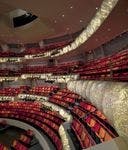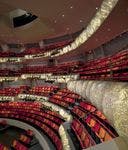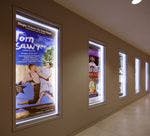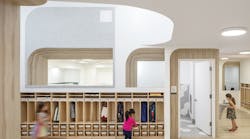The case study details the lighting installation throughout the Muriel Kauffman Theatre including the design of the balcony facades, while highlighting the different Tivoli products used to light other parts of the Center. The full article is available at the Tivoli Lighting website.
The Covelum Designer Series product features a 150° viewing angle and adjustment by 45° up or down. The gold tone was achieved using color mixing of 2300-2400K warm-white LEDs and custom reflectors. Light reflecting off the reflector surfaces combine with angle of incidence on the panels to create a glowing appearance with changing viewing angle.







